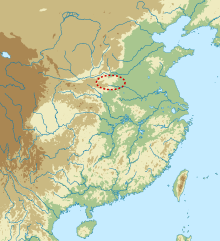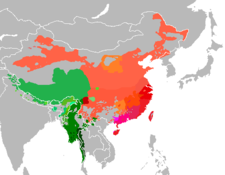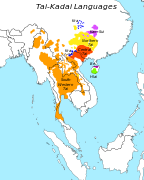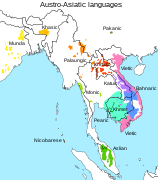東アジア大語族

| 東アジア大語族 | |
|---|---|
| (提唱中、議論中) | |
| 話される地域 | 東アジア、東南アジア、南アジア、オセアニア、マダガスカル |
| 言語系統 | 仮説段階の語族 |
原型 | 東アジア祖語 |
| 下位言語 |
|
| Glottolog | None |
東アジア大語族(ひがしアジアだいごぞく、East Asian languages)は、2001年に言語学者Stanley Starostaによって最初に提案された語族(大語族)である。この提案は、George vanDriemなどの他の言語学者にも採用されている。東アジアと東南アジアのほとんどの言語で構成されており、現在の中国東部、特に華北平原にある共通祖語に由来するとされている[1]。
分類[編集]
初期の仮説[編集]
初期のより小規模の語族の提案:[2]
- オーストロアジア語族、オーストロネシア語族、クラ・ダイ語族、チベット・ビルマ語族: アウグスト・コンラーディ (1916, 1922)[3][4] and Kurt Wulff (1934, 1942)[5][6]
- オーストロアジア語族、オーストロネシア語族、クラ・ダイ語族、モン・ミエン語族:ポール・K・ベネディクト (1942),[7] en:Robert Blust (1996),[8] en:Ilia Peiros (1998)[9]
- オーストロアジア語族、オーストロネシア語族、クラ・ダイ語族、チベット・ビルマ語族、モン・ミエン語族: Stanley Starosta (2001)
東アジア大語族説の先駆説:
- オーストロ・タイ語族 (Kra-Dai and Austronesian): グスタフ・シュレーゲル (1901, 1902),[10][11] Weera Ostapirat (2005)[12][13]
- オーストリック大語族 (Austroasiatic and Austronesian): ヴィルヘルム・シュミット (1906),[14] en:Lawrence Reid (1994, 2005)[15][16]
Starosta (2005)[編集]

Stanley Starosta(2005)[17]の東アジア語族の提案では、オーストロアジア語族とモン・ミエン語族からなる「Yangzian語派」が含まれる。彼は、東アジア祖語は華北平原(特に漢川、渭水、黄河中央部)の裴李崗文化と磁山文化の黍農民によって紀元前6,500年-6,000年に話された二音節(CVCVC)言語であったと考えている[1]。
- East Asian
- オーストロネシア語族(Austronesian)
- 台湾諸語(Formosan)
- Extra-Formosan
- タイ・カダイ語族(Tai-Kadai)
- マレー・ポリネシア語派(Malayo-Polynesian)
- Sino-Tibetan-Yangzian
- シナ・チベット語族(Sino-Tibetan)
- Yangzian
- オーストロアジア語族(Austroasiatic)
- モン・ミエン語族(Hmong-Mien)
- オーストロネシア語族(Austronesian)
Starosta(2005)は、下のような東アジア祖語の形態学的接辞を提案している。これらは、チベット・ビルマ祖語とオーストロネシア祖語、およびニコバル諸語などの形態学的に保守的なオーストロアジア語族に見られる[18]。
- *m(V)- 'agent of V-ing'
- *-Vn 'patient of V-ing'
- *sV- 'instrument of V-ing'
- *n(V)- 'perfective'
van Driem (2012)[編集]
下の東アジア大語族の系統樹は、2012年にベナレス・ヒンドゥ大学で開催された第18回ヒマラヤ言語シンポジウムでジョージ・ヴァン・ドリームによって提案されたものである[2][19]。
- East Asian
- オーストロ・タイ語族(Austro-Tai)
- クラ・ダイ語族(Kradai)
- オーストロネシア語族(Austronesian)
- オーストロアジア語族(Austroasiatic)
- Himalayan-Yangtzean
- Trans-Himalayan
- Sino-Bodic
- Burmo-Qiangic
- Brahmaputran
- Gongduk, etc.
- Kiranti, etc.
- Yangtzean
- モン・ミエン語族(Hmong-Mien)
- Trans-Himalayan
- オーストロ・タイ語族(Austro-Tai)
ヴァン・ドリームによれば、東アジア語族の言語系統樹は、ハプログループO (Y染色体)の系統樹と一致する[20]。 (父系言語仮説)
Larish (2006, 2017)[編集]
Michael D. Larishは、東南アジアと東アジアの言語は、1つの祖語(彼は「原アジア語」と呼ぶ)から派生したものであるとする。 日琉語族は、原アジア語の1つの支派として朝鮮語族と共にグループ化されている。 もう1つの支派は、オーストロネシア語族、オーストロアジア語族、クラ・ダイ語族、モン・ミエン語族、シナ・チベット語族で構成される[21][22]。
- East Asian
- Japano-Koreanic
- Austro-Asian
- オーストロネシア語族(Austronesian)
- オーストロアジア語族(Austroasiatic)
- クラ・ダイ語族(Kra-Daic)
- モン・ミエン語族(Homog-Mien)
- シナ・チベット語族(Sino-Tibetan)
分布[編集]
- シナ・チベット語族の分布
- クラ・ダイ語族の分布
- オーストロアジア語族の分布
- モン・ミエン語族の分布
- オーストロネシア語族の拡散
- 日本語族の分布
- 朝鮮語族の分布
脚注[編集]
- ^ a b Starosta, Stanley (2005). “Proto-East Asian and the origin and dispersal of languages of east and southeast Asia and the Pacific”. The Peopling of East Asia: Putting Together Archaeology, Linguistics and Genetics. London: Routledge Curzon. pp. 182–197. ISBN 978-0-415-32242-3
- ^ a b van Driem, George. 2013. "East Asian ethnolinguistic phylogeography Archived 2019-04-29 at the Wayback Machine.", Bulletin of Chinese Linguistics, 7 (1): 135-188.
- ^ Conrady, August. 1916. Eine merkw rdige Beziehung zwischen den austrischen und den indochinesischen Sprachen. Aufsätze zur Kultur- und Sprachgeschichte vornehmlich des Orients: Ernst Kuhn zum 70. Geburtstage am 7. Februar 1916 gewidmet von Freunden und Schülern, 475-504. München: Verlag von M. & H. Marcus.
- ^ Conrady, August. 1922. Neue austrisch-indochinesische Parallelen. Asia Major: Hirth Anniversary Volume, 23-66. London: Robsthan and Company.
- ^ Wulff, Kurt. 1934. Chinesisch und Tai: Sprachvergleichende Untersuchungen. Copenhagen: Levin & Munksgaard.
- ^ Wulff, Kurt. 1942 [posthumous]. Über das Verhältnis des Malay-Polynesischen zum Indochinesischen. Copenhagen: Munksgaard.
- ^ Benedict, Paul King. 1942. Thai, Kadai and Indonesia: A new alignment in southeastern Asia. American Anthropologist 44:576-601.
- ^ Blust, Robert. 1996. Beyond the Austronesian homeland: The Austric hypothesis and its implications for archaeology. Prehistoric Settlement of the Pacific, ed. by Ward H. Goodenough, 117-160. Philadelphia: American Philosophical Society.
- ^ Peiros, Ilia. 1998. Comparative Linguistics in Southeast Asia. Canberra: Pacific Linguistics.
- ^ Schlegel, Gustave. 1901. Review: ‘Elements of Siamese Grammar by O. Frankfurter, Ph.D., Bangkok: Printed at the American Presbyterian Mission Press, Leipzig, Karl W. Hiersemann, 1900’. T'oung Pao (Série II), II:76-87.
- ^ Schlegel, Gustave. 1902. Siamese Studies. T'oung Pao, New Series II, Volume II, Supplement. Leiden.
- ^ Ostapirat, Weera. 2005. Kra-Dai and Austronesian: Notes on phonological correspondences and vocabulary distribution. The Peopling of East Asia: Putting Together Archaeology, Linguistics and Genetics, ed. by Laurent Sagart, Roger Blench and Alicia Sanchez-Mazas, 107-131. London: Routledge Curzon.
- ^ Ostapirat, Weera. 2013. Austro-Tai revisited. 23rd Annual Meeting of the Southeast Asian Linguistic Society, Chulalongkorn University, Bangkok, 29 May 2013.
- ^ Schmidt, Wilhelm. 1906. Die Mon-Khmer Völker, ein Bindeglied zwischen Völkern Zentral-Asiens und Austronesiens. Archiv für Anthropologie Neue Folge V:59-109.
- ^ Reid, Lawrence A. 1994. Morphological evidence for Austric. Oceanic Linguistics 33.2:323-344.
- ^ Reid, Lawrence A. 2005. The current status of Austric: a review and evaluation of the lexical and morphosyntactic evidence. The Peopling of East Asia: Putting Together Archaeology, Linguistics and Genetics, ed. by Laurent Sagart, Roger Blench and Alicia Sanchez-Mazas, 132-160. London: Routledge Curzon, London.
- ^ Since Starosta died on July 18, 2002, his paper, originally written in 2001, was published posthumously.
- ^ Reid, Lawrence A. (1994). “Morphological evidence for Austric”. Oceanic Linguistics 33 (2): 323–344. doi:10.2307/3623132. hdl:10125/32987. JSTOR i285831. オリジナルの2017-08-15時点におけるアーカイブ。 2020年8月10日閲覧。.
- ^ van Driem, George. 2016. "The Eastern Himalayan corridor in prehistory Archived 2018-10-09 at the Wayback Machine.", pp. 467-524, Vol. II in Elena Nikolaevna Kolpačkova, ed., Проблемы китайского и общего языкознания — Problems in Chinese and General Linguistics. St. Petersburg: Izdatel’stvo Studija « NP-Print ».
- ^ van Driem, George. 2018. "The East Asian linguistic phylum: A reconstruction based on language and genes Archived 2021-01-10 at the Wayback Machine.", Journal of the Asiatic Society, LX (4): 1-38.
- ^ Larish, Michael D. (January 2006). Possible Proto-Asian Archaic Residue and the Statigraphy of Diffusional Cumulation in Austro-Asian Languages (PDF). Tenth International Conference on Austronesian Linguistics. 2019年1月8日時点のオリジナルよりアーカイブ (PDF)。2019年1月7日閲覧。
- ^ Larish, Michael. 2017. Proto-Asian and its branches: An archeolinguistic approach for the history of Eastern Asia. Linguistic Society of the Philippines.






